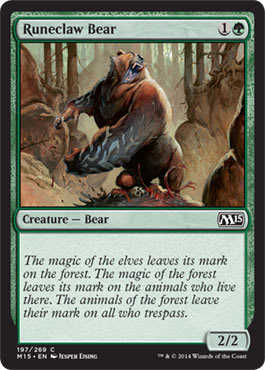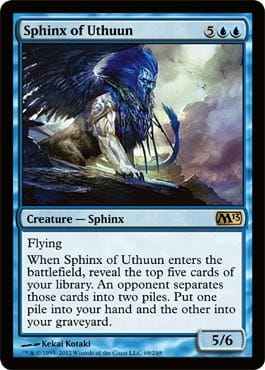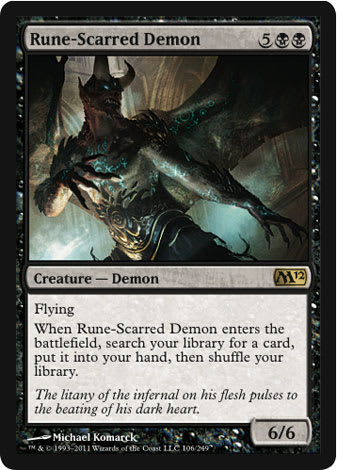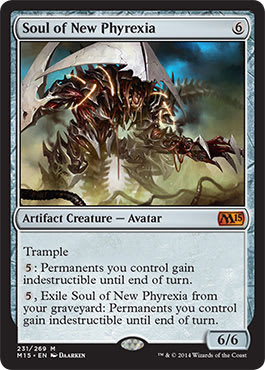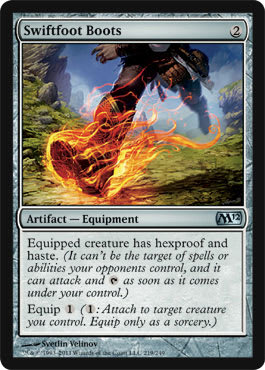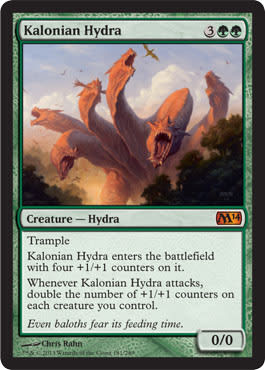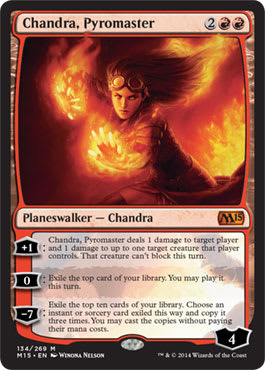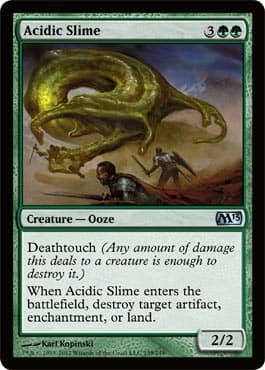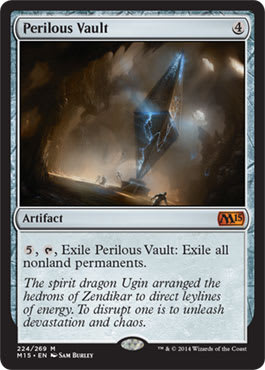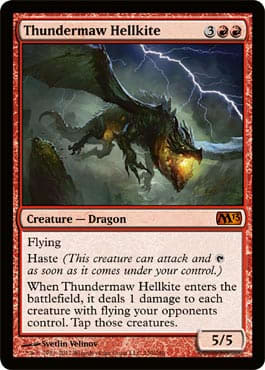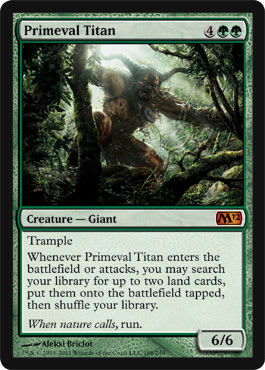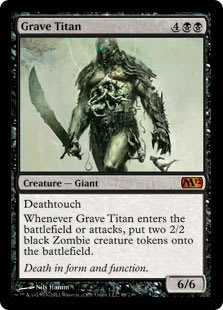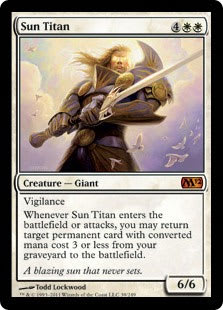Magic Origins is going to be the last core set—at least for a while. It’s sad; I know. For a long time, the core set was populated with reprints from expansion sets or the original one, without any newer cards being published.
But then, it all changed with Magic 2010. The core set began to see the printing of new cards, and in particular, there were a lot of resonant fantasy concepts. Now, there were some gaffes in the early days. For example, Magic 2010 marketed itself as having around fifty percent new cards. Yay! But then we found out that a lot of these new cards were just name changes of older cards, such as Runeclaw Bear for Grizzly Bears and Divination for Counsel of the Soratami. But we still had new cards!
And that trend continued. We saw the introduction of one mechanic from the expansion sets brought out in the cores as well as a lot of iconic and new cards. All the way to Magic 2015, new cards began to hit the streets, beginning their lives in core sets.
In honor of this age of Magic, I thought I would count down the ten best, most iconic, new cards that were introduced between Magic 2010 and Magic 2015, inclusive. What cards endured? What cards really made an impact on kitchen tables everywhere? What cards are still being played?
Honorable Mention 1 — Sphinx of Uthuun and Rune-Scarred Demon
I like big beaters, and I cannot lie. You other players can’t deny. Which would you rather have in your deck, Fact or Fiction or Sphinx of Uthuun? Diabolic Tutor or Rune-Scarred Demon? Unless you are in Bizarro World, the Pro Tour, or some weird Izzet deck that needs more instants and sorceries, you always want the creatures—especially when you have a big ol’ 5-powered flyer. In both cases, you take a perfectly serviceable support role, add 3 mana, and then have a creature that still has that ability, sure, but that can win games—with a big ol’ beater. Win your next Magic night in style!
Honorable Mention 2 — Soul of New Phyrexia
The entire Soul cycle from Magic 2015 is solid, but these cards certainly haven’t proved themselves to be that exciting outside of Limited and the occasionally kitchen-table trick. But this Soul—it’s the good one. At the kitchen table, particularly in multiplayer, someone invariably gets too big for his or her britches and wants to play Day of Judgment. How do you deal with it when you have a creature-heavy deck? Well, one way would be to have some way of making your stuff indestructible. Enter Soul of New Phyrexia. Now, sure, it’s expensive to use the ability, but you gain a free usage when it’s in your graveyard, and don’t forget that it is both a useful colorless trick for any creature deck—regardless of its colors—and a 6/6 beater, so it’s perfectly fine for the red zone of love. Protection and beatings combine for true love from Mirrodin New Phyrexia.
Honorable Mention 3 — Swiftfoot Boots
Who likes having his or her best creature killed by targeted removal? Raise your hand! No one? Exactly! Whether you are playing Commander or Tiny Leaders, Build Your Own Block or Highlander, no one wants to have his or her best dork taken out by an opposing Silence the Believers. What can you do? Well, one thing you can do is to run Swiftfoot Boots! Now your best guy gains haste (yay!) and can’t be hurt by opposing stuff either (although you can still target it with Equipment or Auras or something). Let’s hear it for Boots!
10 — Leyline of Sanctity and Leyline of Anticipation
I didn’t want to toss the whole Leyline cycle up here because one entry was a reprint, so technically, it doesn’t meet the criteria. But these two Leylines are no joke. Both are improvements on major mechanics the color already had. White had Ivory Mask and later descendants, but it didn’t have a hexproof version—nor did it have one that came into play for free on your first turn. Meanwhile, we had cards like Vedalken Orrery running around, but the Leyline of Anticipation gave that to blue—and an iteration on the first turn as well. Both are among the best cards ever printed to this day in their respective houses, and they see a ton of play as a result.
9 — Kalonian Hydra
Kalonian Hydra is many things. It’s a great midsized beater that comes down and initiates swings that can quickly grow out of size. You can run it as a top-end creature for an aggro deck or a midrange creature to add to the other 4- and 5-drops that you are running. But what makes the Hydra really interesting is that it also plays a role as a strong Hydra lord. Hydras almost always have +1/+1 counters, so you can swing and double up all other Hydras you roll. You can also use it as an adjunct to counter-based strategies such as with Ghave, Guru of Spores or Dromoka, the Eternal. Bring the heat and the beats, the feat and the treats.
8 — Jace, Memory Adept and Chandra, Pyromaster
Many of the Planeswalkers that debuted in the core set tended to fall into one of three categories: They were useful tools that weren’t major players (Chandra, the Firebrand), they were specific and not that great outside of a few decks (Liliana of the Dark Realms, Garruk, Apex Predator), or they were weaker entrants overall (Jace, The Living Guildpact). But there were two that really brought it. Chandra, Pyromaster is the strongest version of that character we’ve seen, and she brings red some solid pseudo-card-draw styles along with shooting stuff. Speaking of drawing cards, the Memory Adept version of Jace can draw cards all day long, and he also serves as a useful way to force someone to mill some cards (if you are into that sort of thing). Either way, you get the goods with these versions of Jace and Chandra.
7 — Fauna Shaman
Not only is Survival of the Fittest among the biggest, best, most powerful creature tutors and engines in green’s history, but it’s even been banned in a lot of places. Printing a modern version of it that’s on a 2/2 body is a risk, even though it taps to use the ability. Creatures are generally better than noncreatures since they win games (and the Shaman can be used to discard other copies of itself to activate it, improving in-deck synergy). The Shaman can actually attack and win games. And it’s an interesting take on a card that has always been just too good for Magic. It swings, it wins, and it fits into a lot of decks.
6 — Acidic Slime
Not every new card in a core set has been a tournament powerhouse. In fact, some of the more iconic cards that came were those that had a big change for casual players. You can tell that a card is a new staple of Magic when it keeps being reprinted over and over again, and that’s the Acidic Slime. Casual players love their creatures with enters-the-battlefield triggers. And ever since Uktabi Orangutan, green rocked an uncommon body to blow up something artificial. But this iteration was something—flexible enough to take out three different types of permanents and rocking a deathtouch body to force bad blocks. Acidic Slime has become the new standard for removal, control, and creatures in Magic—especially in the late-night fun stuff.
5 — Steel Overseer
Of all of the plants that we had in the core set to lead into the next year, none was as strong or impactful as Steel Overseer. Clearly created to give artifact creatures serious gas, the Overseer sees play in formats like Modern and even occasionally Legacy. Outside of that stuff, it’s great in many pro-artifact builds that you dream up for the kitchen table as well. With its cheap cost, simple tap mechanic, and pumping of the whole team, it really hits the trifecta of value for casual aficionados.
4 — Perilous Vault
There have been times when Perilous Vault cracked into various constructed builds. Plus, I don’t think it’s an accident that right after the era of the indestructible Gods, every deck had an answer with exiling love in case those Gods went out of hand. Ever since it was printed last summer, the Vault has cleaned out an untold number of boards, and it has taken out a lot of problematic commanders and minions alike. Its exiling removal handles unsightly problems, and from a fully en-pants’d Uril, the Miststalker to a broken board with too many Slivers to count, it handles everything—no muss, no fuss.
3 — Thundermaw Hellkite
Thundermaw Hellkite was to red what Baneslayer Angel was to white. After the power of the Baneslayer Angel, and an era ruled by it, a lot of folks were wondering if Wizards of the Coast would print a creature that good again. They did so just two years after Baneslayer Angel left Standard in the form of Thundermaw Hellkite. It’s another 5/5 flying 5-drop with a slate of abilities, and better yet, the Hellkite gave red decks the sort of big-hitter finisher they usually lacked. Whether playing it in Standard or at Magic night in your friend’s basement, you were never afraid to drop the Hellkite, tap some flyers, and swing. (Did you know that I cracked a foil Thundermaw Hellkite in Draft shortly after the set’s release? That was a good Friday Night Magic Draft.)
2 — The Titan Cycle
I don’t think it’s cheating to have these five cards in one spot. Ever since they were printed, these five guys have really shown various stylings. From Frost Titan in Standard control builds to Primeval Titan’s fetching of special lands, they have used a variety of tournament builds. Now, they’ve all been overprinted into oblivion. From Commander to Duel Decks, they have been printed so often that their secondary-market values (save for Primeval Titan) are collectively in a tailspin. Compare to number 1 to see how holding off on reprints can really change that (although, to be fair, I think we’ll see number 1 in a From the Vault this summer). But no one can deny how powerful a Grave Titan or Sun Titan can be in a lot of decks.
1 — Baneslayer Angel
What makes the Baneslayer Angel the best of the new slate of core-set cards? Well, there are a few things. First of all, it proved from the get-go that not every new card in this age of Magic core sets would be simple renamings of older cards. This ain’t no Mind Control or Blinding Mage! Baneslayer Angel was awesome, and it dominated Standard and kitchen tables alike with its awesomeness. Even today, it’s probably among the most beloved nonlegendary Angels of all time, and that’s saying something in a tribe that’s as beloved as Angels. The Baneslayer Angel is strong, it never does you wrong, and it breaks things with aplomb.
And there we go! Are you ready for Magic Origins fun? What cards that debuted since Magic 2010 are on your list?
















